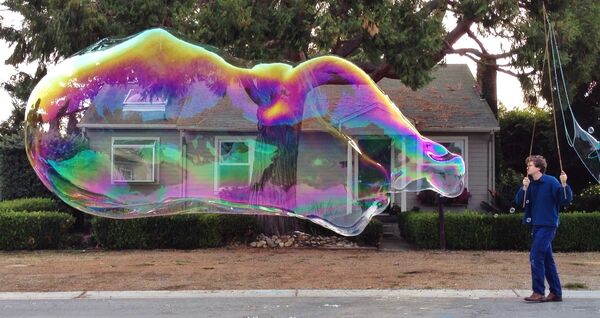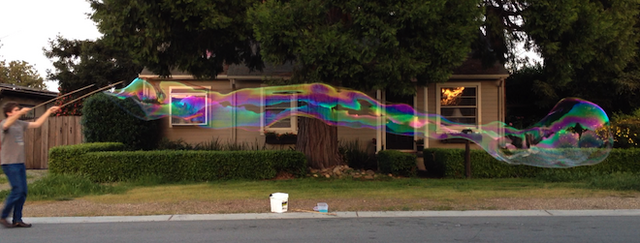No edit summary |
Tag: Visual edit |
||
| Line 99: | Line 99: | ||
The "stringiness" of your diluted mix is a clue. If your diluted mix is not "stringy" at all, use more PEO. |
The "stringiness" of your diluted mix is a clue. If your diluted mix is not "stringy" at all, use more PEO. |
||
| − | EDWARD: Add more detailed notes here! |
+ | EDWARD: Add more detailed notes here! (or a link to a separate page of notes would be less cluttery and confusing :) |
==Videos== |
==Videos== |
||
Revision as of 11:11, 13 October 2014

eGoo giant with a 100" top-string loop with cool temperature and high humidity.
EGoo 1.5 (UPDATED JULY/OCTOBER 2014)

Jakey and the Giant Bubbles
An early test using a bit more WSR301 than the current recipe. Watch full-size at HD resolution.

2012 04 28 rayon modular 4 1 blue, egoo
An Egoo test session. Watch full-size at HD resolution.

2012 04 28 modular 32" rayon loop 4 1 white
Another Egoo test run
eGoo is a bubble super-concentrate suitable for achieving a wide range of dilutions. You may find it fruitful to tinker with the amounts to achieve your preferred feel. With this recipe, you can achieve a friendly juice whose water-to-detergent ratio ranges from 20:1 to 35:1. At the upper dilution range, you may find that you need to supplement with some additional PEO or BLM (a PEO-based bubble juice additive)
Updated July 2014: amounts adjusted for full-strength PEO. Original recipe here.
Recipe
The following recipe makes 8 oz (roughly 1/4 liter) of eGoo when diluted with 15 parts water. The recommended dilution range is 12 to 22 parts water per 1 part concentrate. I recommend trying 12.5:1, 15:1 and 20:1.
The recipe scales up well by doubling, tripling or quadrupling all of the ingredients. We recommend mixing up at least a quadruple batch to minimize measurement error.
Ingredients
- 0.15 - 0.25 grams WSR301 or 0.6-1.0 grams J-Lube. Amounts will need to be adjusted if your PEO has degraded (see notes below)
- 3.2 grams baking soda
- 1.6 grams citric acid
- 76 grams room temperature or warm (not hot) water
- 146 grams Dawn Pro or equivalent detergent
Steps
Fizz mix the PEO. Combine powders in a narrow-bottomed tall container (if available). It needs to be tall-enough to contain the foam that will be created when the fizzing starts. Start stirring the powders before you start to pour the water. While stirring the powder, add the water and continue stirring until the foam has subsided and you have a nice uniform mix (this can take 30 seconds to a couple of minutes). NOTE: You do not need to use fizz mixing. If you have another preferred method of mixing up PEO, feel free to use your preferred method. Click here to see a video of Fizz Mixing. ALTERNATE FIZZ MIX: Another way to fizz mix is to mix the powders well in a small cup and drizzle the powder mix into the water as it is being stirred. When you do this, you might want to reserve half the citric acid and add it after mixing is complete to minimize the likelihood of overflowing the container with fizz.
Add the Dawn Pro after the fizzing and foam have subsided. Stir gently to mix the detergent and goo. You want a uniform mix.
It is best to let the goo sit for 10 to 15 minutes before using although it can be diluted right away for use.
This concentrate seems to have a very nice shelf-life at a reasonable room temperature.
Diluting the Concentrate
This recipe was developed to accommodate a range of dilutions from about 12 parts to 22 parts water per part concentrate.
To use the concentrate, measure out your water and add the desired amount of concentrate. Stir gently. This concentrate can be quite gooey and can benefit from at least a few minutes rest. Overnight may be even better.
Add a pH adjuster. After diluting, per liter of added water add one of the following:
- 1/2 slightly heaping teaspoon baking powder
- 1 gram baking soda+1/2 gram citric acid (per liter water)
- 1/4 teaspoon Cream of Tartar (per liter water)
- 5-8 ml of a 5% citric acid solution (equivalent to adding )
- 0.25-0.4 grams citric acid
The pH adjustment improves the juice performance enormously but is best not included in the concentrate because the best performance results when it is added to the fully-diluted juice.
Dilution Table
The table below shows information about diluted eGoo at various water:concentrate ratios. It includes a column that will be especially convenient to people that like to dilute using measuring cups. When diluting by volume try to be as accurate as possible. Tablespoons are an American measure that is equivalent to 0.5 fluid ounces.
| Water:Conc. Ratio | Resulting Water:Det. Ratio | Water to Add to 1/4 cup eGoo | PEO% | Notes |
|---|---|---|---|---|
| 12.5:1 | 20:1 | 3 cups + 2 tbsp | 0.005% | |
| 15:1 | 23.8:1 | 3-3/4 cups | 0.004..% | |
| 16.4:1 | 25:1 | 4 cups + 2 tbsp | 0.004..% | |
| 19:1 | 30:1 | 4-3/4 cups | 0.0034% | |
| 20:1 | 31.7:1 | 5 cups | 0.0032% | |
| 22:1 | 35:1 | 5-1/2 cups | 0.0029% |
% PEO is calculated as a function of total water rather than as a function of the total bubble juice
QUICK TIP! MAKING A GALLON OF JUICE. To make one gallon of diluted juice with an approximate water:detergent ratio of 16.5:1 use 217 grams of eGoo concentrate and 3574 grams water.
Adjusting the PEO Amount
PEO, the active ingredient in J-Lube and Poly-Ox WSR301, are prone to degrading over time. Oftentimes, newly-purchased PEO has degraded on the vendor's shelf. Don't worry. Degraded PEO works great (some people even prefer it). You just need to use more of it. It is not uncommon for it to degrade to about 1/4 strength.
The "stringiness" of your diluted mix is a clue. If your diluted mix is not "stringy" at all, use more PEO.
EDWARD: Add more detailed notes here! (or a link to a separate page of notes would be less cluttery and confusing :)
Videos

2012 08 31 36 foot tube
Long closed tube (2012 08 31) . The video is just one dip of a 72-inch topstring loop. The top-string is full-ply rayon mop yarn. The bottom string is just 2-strands of the rayon mop yarn. This is a modular loop (top and bottom just clipped onto the leads). The closed tube is at least 36 feet long. (The lines in the street are 10 feet apart and the street width is 21 feet from middle-of-gutter to middle-of-gutter). The water:concentrate ratio was 17:1. Temp: 58F. Humidity: 82%

2012 07 20 The Bubble And The Crow
A couple of long-lasting pretty big bubbles, one of which is attacked by a large crow. Water:concentrate ratio: 20:1 (>30:1 water:detergent ratio). Conditions pretty good with 65% humidity. Full-sun. 63F. 2012 07 20 test session.

2012 07 20 Egoo Tests - LONG
A long session with eGoo. This is a 13 minute video of a complete session with no dips edited out to give you a feel for how well-behaving eGoo should perform under nice conditions.
Windy unfavorable conditions. 20:1 water:concentrate ratio, strong winds, 50% humidity and 70F. 2012 07 21 evening test session. This large bubble doesn't last long due to the very strong wind. But the color is great. The smaller bubbles that broke off -- however -- lasted a long time.
Long tubes (2012 08 30) . I spent a few minutes making tubes with a 32" topstring loop. The loop was Lehigh SecureLine diamond braid cord which has pretty good capacity (but nowhere near the capacity of the Rubbermaid mop yarns). Conditions were 66F and 62% humidity with only a slight breeze. The tubes would have been longer with a somewhat stronger breeze. This should give you an idea of what eGoo can do. The dilution was 17:1 water:concentrate (a bit more than 25:1 water:detergent).

